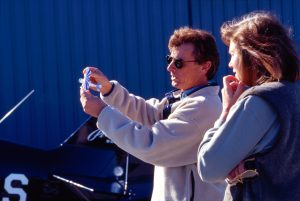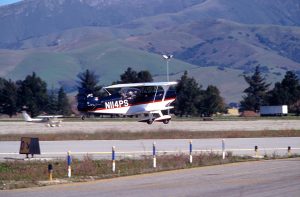I thought I was doing fine flying loops and rolls, even a hammerhead, in the brand-new Pitts S2C with only 36 hours on the tachometer. A half-hour earlier, Sean D. Tucker (yes, world-famous airshow performer Sean D. Tucker) had said jokingly, “Now don’t lose your lunch in my new airplane, Laurel.” But, the flat spin did me in.
I was in this position because a few months earlier I had attended my first Women in Aviation International (WAI) conference in Denver, Colo. It was full of young women, like bees on a flower bush, buzzing around from booth to booth looking for commercial flying jobs. I was merely working toward becoming a flight instructor, a goal already attained by most of the women (who were far younger than my 50 years).
Not looking for a job, I had plenty of time to hang around the fund-raising silent auction table where I found one item I was willing to bid on: two hours of aerobatic flight lessons with Sean D. Tucker. His home base is Salinas, Calif., a four-hour drive from my home in Truckee, Calif., so it wasn’t an impossible wish. I had no idea what it was worth, but I thought I could afford $400 for a once-in-a-lifetime experience.
About an hour before the bidding closed, I noticed that I was competing with one other woman who was raising the bid $20 every time. The price was up to $500, but I caught a glimpse of her across the room—twenty-ish, tall, blond, attractive, with a whole flying life ahead of her—and was inspired.
In the final moments, my competitor and I were standing shoulder to shoulder at the auction table with pens in hand. As she wrote in $600, she said, “I can’t really afford this.” Quickly scribbling $620 on the next line, I responded, “I can’t either, but I’m older than you, and this may be my last chance.” Perhaps she was relieved. I’ll never know, but she put down the pen and walked away.
When I realized what I had done, I felt sick. Not that I had outbid my youthful rival, but that I had just unwittingly spent $620. With Sean D. Tucker’s photo and prize receipt in hand, I entered the elevator to return to my room and lament what I had done. A small dark-haired young woman who had watched the battle at the auction table was there, too. “That’s so cool,” she said. “I’d give anything to fly with Sean Tucker, but I’d settle for a photo.” I handed her the picture and thought maybe I was taking home something after all.
When I met Sean at the Salinas airport for my first lesson in February 1999, he made me feel relaxed. My entire aerobatic experience had been a few spins in a tired Cessna 172. By that time, I was a new flight instructor and had demonstrated spins in my CFI training, but I had no idea what one would feel like in a new biplane made for aerobatic maneuvers. Sean illustrated what we would be doing using a toy airplane to demonstrate the airplane’s attitude. He said we would fly four different times, a half-hour each time.
I put on the parachute he provided and climbed into the backseat after he instructed me on how to get into the cockpit using the handholds and stepping only on the white crossbars on the see-through floor. Before climbing into the front seat, Sean identified the instruments and gauges, pointing out that there was no turn coordinator. I would have to “feel” the airplane with my bottom side. Then, he showed me the red knob near the window that unlocks the clear canopy in case of emergency. “When will I know it’s time to jump?” I asked. “When you see me gone, it’s time,” Sean joked.
He showed me how to start the engine and adjust the trim slightly “south,” or nose-down. We performed the run-up, and were off. The nearby practice area was a farm owned by a friend of Sean’s. My husband Tom had driven over to watch us from below as we did loops, rolls, spins, and hammerheads. Sean demonstrated the maneuvers, then instructed me to follow through and do some on my own. The half-hour passed quickly, and when Sean asked how I was feeling, I said, “Great!”
With that, he took the controls and put the Pitts into a flat spin. It was like one of those spinning carnival rides, which make me sick just thinking about them. It didn’t last long, but it was long enough. Sean asked again how I was doing. I think I said, “Okay,” but I’m not sure. He headed toward the airport, and in ten minutes, we were on the ground. Tom was waiting for us, but I couldn’t move. After a minute, however, I knew I’d better move, and fast.
A few steps out of the airplane, and I was losing my lunch on the grass. I didn’t gauge the wind direction and was soon covered with it. Sean and Tom were laughing and gave me a demonstration on how to face downwind, something every man learns at a young age. I didn’t care; I was simply relieved that my lunch was on me and not in the new Pitts.
Although it took me all afternoon to recover, the next day I felt fine, eager to do anything but flat spins. Two weeks later, I returned to Salinas for my final two lessons. Tom and I brought along Wanda, his 85-year-old mother, and Helen, our 84-year-old friend who lives in Carmel, to watch. They were in on the preflight briefing, even asking questions about what we would be doing up there. As Sean and I taxied out to takeoff, Tom drove the twosome to the practice area for the show.
Sean and I flew a variety of maneuvers over the open field; I was becoming more comfortable with the controls and their effect. We did a hammerhead over the base of a small hill, which Wanda identified immediately, I learned later. Then, Sean said, “I’ll take the controls.” He pulled the nose up, turned the airplane toward our three spectators standing next to the car at the other end of the field, and pointed it toward the ground for speed. We were getting set up for a high-speed pass—or so I thought. At the last moment, Sean inverted the airplane overhead, thrilling them and me. For the one and only time in my life, I was an aerobatic pilot with an audience.
At dinner that night, Wanda and Helen couldn’t stop talking about the “airshow.” It was an experience that they and I would never forget. And all because I felt alone in Denver and grabbed a chance. Even though I haven’t been upside down in an airplane since then, I wouldn’t trade the experience of flying with Sean D. Tucker for any amount of money. He donated the gift of flight lessons to WAI, and I was beneficiary. Sean still greets Tom and me like old friends when we see him performing at Oshkosh every year. I’m not sure if it’s because I managed to get to the lawn in time, or whether he’s just a great guy.






